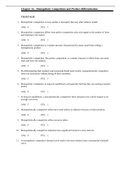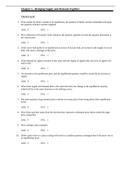Econ 301 chapter 13 - Study guides, Class notes & Summaries
Looking for the best study guides, study notes and summaries about Econ 301 chapter 13? On this page you'll find 4 study documents about Econ 301 chapter 13.
All 4 results
Sort by

-
ECON 301-Chapter 13—Monopoly and Antitrust . Questions and Answers
- Exam (elaborations) • 36 pages • 2021
- Available in package deal
-
- $9.99
- + learn more
ECON 301-Chapter 13—Monopoly and Antitrust . Questions and Answers TRUE/FALSE 1. Control of a scarce resource or input can serve as an entry barrier. ANS: T PTS: 1 2. A monopoly firm can sell as much output as it wants at whatever price it sets. ANS: F PTS: 1 3. Monopolies will tend to produce a greater quantity and charge higher prices than perfectly competitive industries. ANS: F PTS: 1 4. A profit-maximizing monopolist will choose to operate along the inelastic portion of its dem...

-
ECON 301-Chapter 14—Monopolistic Competition and Product Differentiation. Questions and Answers
- Exam (elaborations) • 30 pages • 2021
- Available in package deal
-
- $9.99
- + learn more
ECON 301-Chapter 14—Monopolistic Competition and Product Differentiation. Questions and Answers TRUE/FALSE 1. Monopolistic competition is more similar to monopoly than any other industry model. ANS: F PTS: 1 2. Monopolistic competition differs from perfect competition only with regard to the number of firms participating in the market. ANS: F PTS: 1 3. Monopolistic competition is a market structure characterized by many small firms selling a homogeneous product. ANS: F PTS: 1 4. Mo...

-
ECON 301-Chapter 6—Elasticities. Questions and Answers
- Exam (elaborations) • 39 pages • 2021
- Available in package deal
-
- $10.99
- + learn more
ECON 301-Chapter 6—Elasticities. Questions and Answers TRUE/FALSE 1. Price elasticity is a measure of the relative responsiveness of the change in quantity demanded to a change in price. ANS: T PTS: 1 2. Price elasticity is a measure of the relative responsiveness of the change in price to a change in quantity demanded. ANS: F PTS: 1 3. Moving along an inelastic portion of a demand curve, the change in quantity demanded will always be proportionally less than the change in price. A...

-
ECON 301-Chapter 5—Bringing Supply and Demand Together. QUESTIONS and ANSWERS
- Exam (elaborations) • 43 pages • 2021
- Available in package deal
-
- $9.49
- + learn more
ECON 301-Chapter 5—Bringing Supply and Demand Together. QUESTIONS and ANSWERS TRUE/FALSE 1. If the market for Rolex watches is in equilibrium, the quantity of Rolex watches demanded will equal the quantity of Rolex watches supplied. ANS: T PTS: 1 2. Price reductions will usually result whenever the quantity supplied exceeds the quantity demanded at the current price. ANS: T PTS: 1 3. If the soccer ball market is in equilibrium at a price of $22 per ball, an increase in the supply of ...

$6.50 for your textbook summary multiplied by 100 fellow students... Do the math: that's a lot of money! Don't be a thief of your own wallet and start uploading yours now. Discover all about earning on Stuvia


